A Vermont Insulator Hunt
by Barry Conolly
Reprinted from "Crown Jewels of the Wire", April 1991, page 14
My story begins when my wife, Sharon, and I went on a tour of an area marble
quarry. This quarry is located in southwestern Vermont and was started in the
first decade of this century. Still active, the quarry covers 27 acres and is
contained completely within a mountain. It is not open to the sky, as quarries
usually are. Trucks now drive over a half mile into the mountain to pick up
their loads of the translucent white marble.
The quarry, and several inactive
ones, are located at the 1600 foot elevation of the mountain, about 1000 feet
above the valley floor. In the first part of this century, an inclined railroad
was built to transport the marble quarried from them down to the valley below.
Powerful electrically-driven winches were used to move the flatbed rail cars up
and down the steep mountain side. It is this abandoned railroad, with its
derelict support facilities, that provided a rare opportunity to recover some
remarkable insulators.
After the tour, Sharon and I followed the railroad bed up
to an older quarry, and came upon an abandoned power substation. On the lower
half of its split roof was an iron scaffolding that supported a number of multiparts, most of which were shattered. On the ground we found several more
broken multiparts and a badly damaged Pyrex CD 327. Being a collector, I found
it very disheartening to see these broken insulators, especially since I did not
have them in my collection.
Just inside the open doorway of the substation was a
sight that I will never forget. Fifteen feet up on an interior wall, were 5
horizontally mounted M-3740s. Four of the five insulators were in mint
condition, obviously protected for many decades by the building.
They were
spectacular. Their glazes were varied. On one, all 3 shells were a rich mahogany
brown. On the others each shell was different, varying from black, black with a
coffee cream, and mahogany.
In what Sharon later described as "frightening
behavior", I attempted to recover one of the insulators. Using a
half-rotten ladder found in a back room, I was able to climb up to just below an
M-3740. By leaning out from the ladder, with my arms stretched out above me, I
was able to firmly grab its top skirt. I then gave it as strong a twist as my
situation would allow. Fortunately, the insulator refused to budge. If it had
come free, I would have found myself in a backward swan dive with 25 pounds of
antique porcelain, headed for the concrete floor below.
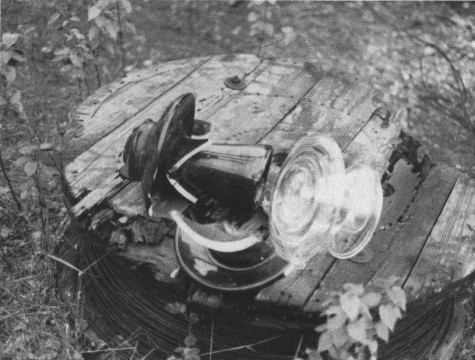
A smashed Thomas M-3450 and a CD 327 Pyrex.
I fitted several pieces of the CD
327 together for the photograph.
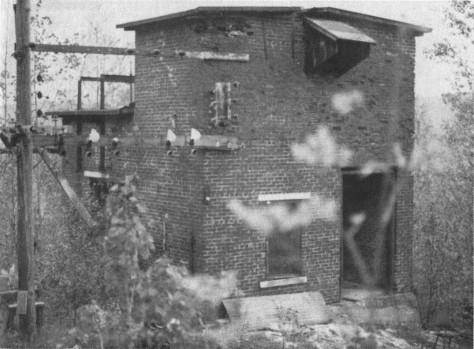
The long abandoned power substation containing
the five M-3740s.
The M-2750 and M-3280 were mounted on the iron work on the
lower roof.
It was a second, better-planned trip with my friend Marty that brought
success. The M-3740s were bolted in pairs to steel plates, and these steel
plates were in turn bolted to the wall. Because the insulators were solidly
cemented to their pins, we tried to unbolt them from the plates. Our attempts
proved useless because the nuts and bolts were frozen and rotated as one piece.
Since we were not going to get them down individually we developed an
alternate plan. We passed a strong rope through an eye bolt screwed into the
roof, and then tied the rope to the top insulator. Once the rope was secured, I
removed the four comer bolts holding the steel plate to the wall, and the plate
with its two insulators, a total of 115 pounds, was then gently lowered to the
floor. I understand now why large multiparts are often called "boat
anchors".
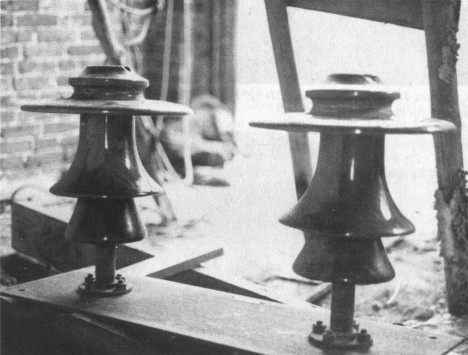
The first two M-3740s off the wall. These Lily-Shell
design insulators had a nominal voltage rating of 66kv.
I also recovered a Locke M-2750 and a No Name M-3280 from the building. The
No Name has the same "D.R.R.E." incuse marking found on an M-3122
owned by Milo Holland and reported on by Elton in the January '90 issue of Crown
Jewels of the Wire. On my insulator, the marking is on the underside of the
top skirt.
An old transmission line with most of its cedar poles down runs through the
area and has yielded three Thomas M-3450s, and a mint Pyrex clear glass CD 327.
The CD 327 was a thrill to find, especially after seeing the earlier broken one.
Other distribution poles and building-mounted brackets have produced a number of
U-425As and two mint OB U-736 ST-type insulators.
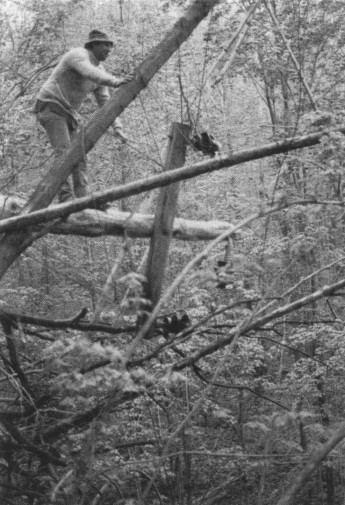
Marty checks out a fallen transmission line pole with
3 Thomas M-3450s. The one at the end of the pole was mint.
The abandoned upper quarry is small and penetrates only 400 feet into the
side of the mountain. Inside, I saw a number of crossarms bolted to the walls,
but all were empty of glass.
In a deep pit to the right, however, there was a single glass insulator. It
was located on an inaccessible wall, and was too far away and too dirty to
identify. Since the pit was flooded, I had to wait until this winter for a
chance to recover it.
I returned in mid-January once the water had frozen, and made a 50 foot
rappel down to the ice. I was then able to walk over to the wall, climb up 10
feet, and get what turned out to be a blue Star CD 200. My initial excitement
was dampened when I found that the CD 200, although still on its iron pin and
threaded wooden plug, was perfectly split in half length-wise. There was a small
dome ding indicating a point of impact.
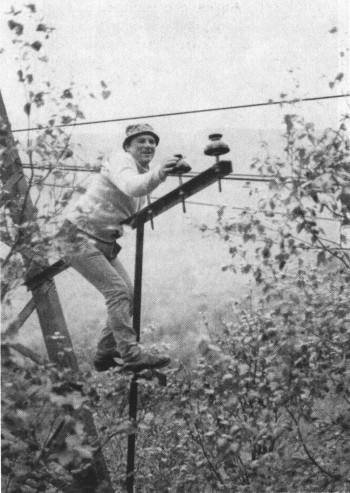
Marty recovers two Ohio Brass U-726 (Silent Type) insulators.
I have no idea what such an uncommon transposition insulator was doing in
this setting. You never know what you are going to find when you are insulator
hunting, that is what makes it so much fun. One thing that is for sure, the ones
you find yourself are always the very best.
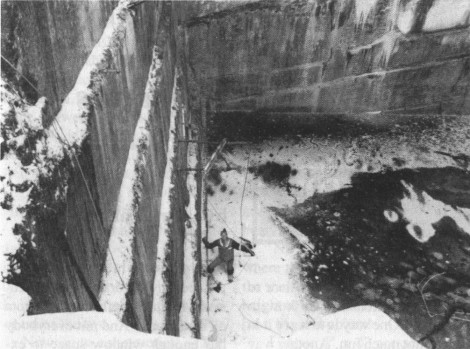
The pit where the Star CD 200 was found. The quarry wall (left)
where I am standing rises over a hundred feet to the roof of the quarry.
The rappel rope is in the foreground.
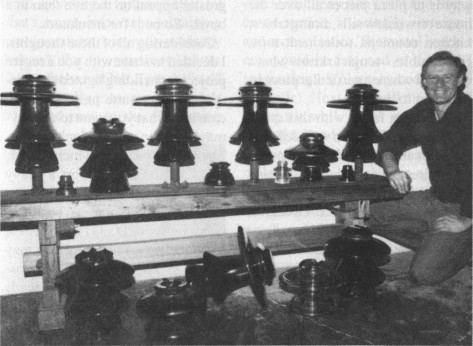
The four mint M-3740s and the other recovered insulators.
The M-3740 on the floor had a chipped wire groove.
| 